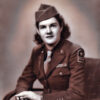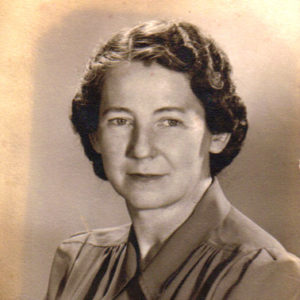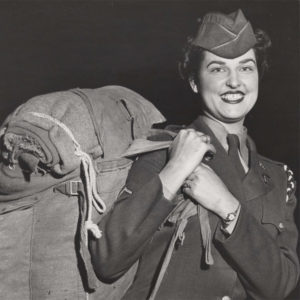calsfoundation@cals.org
Women's Auxiliary Army Corps (WAAC)
Before World War II, Arkansas was predominately an agricultural state, and jobs for women were very limited. Serving in the Women’s Auxiliary Army Corps (WAAC) gave Arkansas women a chance to assist in the war efforts and to do jobs they never thought they could do. Women in the WAAC aided the war effort in a variety of roles across the state and nation.
On May 28, 1941, as the United States was preparing for the possibility of becoming involved in World War II, Congresswoman Edith Nourse Rogers of Massachusetts introduced a bill to the U.S. Congress to establish the Women’s Auxiliary Army Corps. Rogers used what women had done in the navy and marines in World War I as a model. It took the bombing of Pearl Harbor on December 7, 1941, and the entrance of the United States into World War II to gain support for Rogers’s legislation. First Lady Eleanor Roosevelt and General George Marshall got behind the bill, and the bill passed on May 14, 1942.
Colonel Oveta Culp Hobby was named the director of the WAAC. The first training center was established at Fort Des Moines, Iowa. The first group of enlistees, consisting of 400 basic trainees and 200 officer trainees, reported to Fort Des Moines on July 20, 1942. Margaret H. Letzig of Little Rock (Pulaski County) was the first Arkansas woman to be accepted for officers’ training in that first group of enlistees. She served as a WAAC officer until 1943, when she was honorably discharged.
The WAACs were employed to free men from their non-combat duties so that they could go to combat zones. The women were not trained to use weapons and were not to serve in the combat front lines. At first, women in the WAAC were not well accepted by many of the general public, and jokes were made about the enlistees. A September 5, 1942, Arkansas Gazette headline read, “Arkansas’s First Private in the ‘Wackies’ to Leave Tomorrow.” The article further stated that Clara “Sis” Hicks of Little Rock and Lonoke (Lonoke County) was the first private from Arkansas to be accepted for basic training. The article continued to say that several Arkansas women were training to be “Wacky” officers.
Basic training for the WAAC was eight weeks long and closely followed the basic training for the male trainees. The program was rigorous with exercises, close-order drills, classes on military subjects, and more. The WAACs had a five-and-a-half-day work week. Saturday afternoons and Sundays were not scheduled for training, but women were often studying for the next exam during this time. After completing basic training, the WAACs either went to duty stations or were sent to specialist training programs.
The second and third WAAC basic training centers were established shortly after the first. By October 1942, a separate recruiting center from the army’s was established in Little Rock for WAACs with WAAC recruiters. The first overseas detachment of WAACs was sent to General Dwight D. Eisenhower’s headquarters in North Africa early in 1943. Betty Jane Eshelman, formerly of Fort Smith (Sebastian County), was one of that first group of WAACs in North Africa.
By the beginning of 1943, the WAACs were proving that they could do the jobs asked of them, and additional women were recruited. A draft of women was even considered but failed to be approved. Recruitment quotas for WAAC inductees were set for each county in Arkansas, and local civilian procurement committees were organized to help with recruiting.
The fourth WAAC basic training center was opened in March 1943 at Fort Devens, Massachusetts. More basic training space was badly needed, and the only space that the army was able to make available for the fifth WAAC basic training center was three prisoner-of-war (POW) camps at Camps Ruston and Polk in Louisiana, along with Camp Monticello in Drew County, Arkansas. The camps were made available if the women made no changes to the plumbing, the sparse living quarters, and the barbed-wire fences, and if they would leave within thirty days if the camps were needed for prisoners of war.
The first WAACs arrived at Camp Monticello on March 14, 1943. Others continued to arrive in the next few days. On March 23, about 100 WAACs passed in review around the civic center for the citizens of Monticello (Drew County). On April 3, Arkansas A&M College (now the University of Arkansas at Monticello) held a dance for the WAACs. Col. Hobby arrived at Camp Monticello on May 5, 1943, to inspect the camp. By June 1943, the camps were needed for Italian prisoners of war, and the fifth basic training program closed.
In addition to the five basic training centers, several specialist schools were set up around the United States. In February 1943, two administration schools for WAACs were opened at Arkansas Polytechnic College (now Arkansas Tech University) in Russellville (Pope County) and Arkansas State Teachers College (now the University of Central Arkansas) in Conway (Faulkner County). WAACs at the two colleges attended so-called “paper schools” and received training in army forms and office administration. The trainees arrived in contingents of 250 to 300 and stayed at the schools six to eight weeks. During the time the WAACs were at the colleges, they participated in recruiting parades in Little Rock and Fort Smith. Often, male army troops from Camp Joseph T. Robinson and Camp Chaffee (now Fort Chaffee) participated in the parades. Military Police (MPs) of both male soldiers and WAACs accompanied the groups. The female MPs were the only WAACs to receive weapons training. About 850 WAACs received training at Arkansas Polytechnic College and 1,800 at Arkansas State Teachers College during the time the programs were in effect.
Until November 1, 1942, when Congress passed legislation that equalized pay rates, pay was less for women in the same rank and doing the same jobs as the men they replaced. Another bill introduced by Rogers, and signed into law on July 1, 1943, dropped “auxiliary” from the name; this made the women part of the U.S. Army, though they continued as a separate division, the Women’s Army Corps (WAC).
On September 9, 1943, the first medical technical school for WACs opened at the Army and Navy General Hospital in Hot Springs (Garland County). Some of the first 145 WACs were assigned to six-week courses for medical or surgical technicians. Others were assigned to twelve-week courses for dental, laboratory, or x-ray technicians. Later, training in physical or occupational therapy was added to the school’s courses. The school was conducted in the Eastman Annex that was connected by an overhead walkway with the hospital. As the WAC units completed their respective courses, they were sent to duty stations around the United States, and some were sent overseas.
WAAC/WAC units were assigned to several duty stations around Arkansas, including Camp Robinson, Camp Chaffee, the Army and Navy General Hospital, and the Walnut Ridge Flying School. At first, illiterate men were not accepted into the army, but that soon changed; in response, some WACs at Camps Robinson and Chaffee began teaching reading and writing to illiterate soldiers training there. At the Army and Navy Hospital, a reconditioning program was started to help patients with the transition to civilian life, and WACs taught high school courses and courses in life skills for the patients at the hospital. Other WACs worked as technicians in the hospital, and some worked in other capacities around the facility.
WACs who were trained in Chemical Warfare Services (CWS) arrived at the Pine Bluff Arsenal in early April 1943. This WAC detachment soon was reported to be suffering from low morale because they felt they were replacing civilians rather than soldiers. The inspectors reported that the WACs should have no reason for low morale as they were doing jobs that were needed for the war effort. The so-called “malcontents” among the WACs there left the arsenal, and morale improved.
The jobs the WACs did at the Pine Bluff Arsenal were typical of the variety of jobs WACs performed. WACs drove, serviced, and cleaned the large army buses that connected the widely separated munitions buildings, transporting civilian shift workers twenty-four hours a day. Other WACs ran the arsenal’s military personnel section. WACs in the quartermaster branch handled stock records, requisitions, inventories, shipping tickets, and reports. One WAC ran the commissary. Other WACs computed field rations, sorted mail, handled publications, ran the motor pool, served as librarians, assisted in the payroll section, inspected the seven facility cafeterias, and ran the officers’ mess. One WAC lieutenant was chief of the chemical production control section and coordinated manufacture and shipping schedules. Only a few jobs for WACs in the CWS were technical ones that concerned the chemical warfare mission of the United States.
The WAC program was originally supposed to be discontinued six months after the end of World War II. However, the women proved themselves to be an indispensable part of the military force of the nation, proficient in 239 different army jobs they were trained to perform. The WAC, therefore, continued until 1978, after which time both women and men served together in the U.S. Army.
For additional information:
“Arkansas’s First Private in the ‘Wackies’.” Lonoke County Historical Society Newsletter, Winter 2006–2007, p. 3.
Drew County Archives, Drew County Museum, Monticello, Arkansas.
Droessler, William, “The WAACs Are Coming! Monticello’s Three-Month Affair with the Women’s Auxiliary Corps.” Drew County Historical Journal 14 (1999): 4–9.
Treadwell, Mattie E. United States Army in World War II, Special Studies, The Women’s Army Corps. Washington DC: Department of the Army, 1954.
Carolyn Yancey Kent
Jacksonville, Arkansas
 Babcock, Lucille (Lucy)
Babcock, Lucille (Lucy) Lucille Babcock
Lucille Babcock  Margaret Heller Himstedt Letzig
Margaret Heller Himstedt Letzig  Maxine Powell
Maxine Powell 




Comments
No comments on this entry yet.